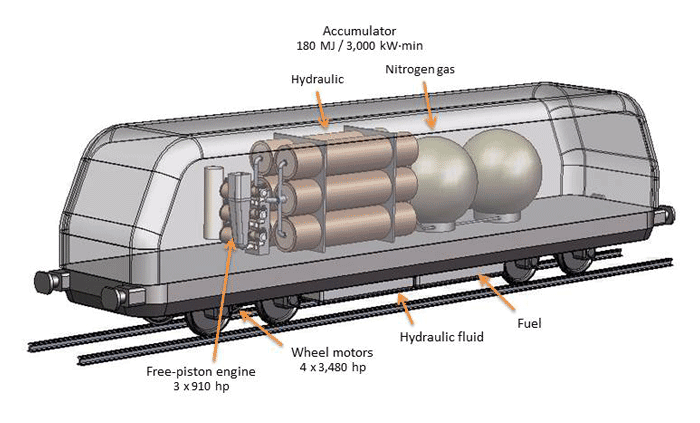The ease of transmitting and storing high powers, the robust construction, and low consumption of the advanced hydrostatic drivetrain for locomotives result in significant benefits regarding performance, operating characteristics, and costs.

| Weight |
80 to |
80 to |
| Starting Tracktive Efford |
25 to |
250 kN |
| Length |
52.5 ft. |
16 m |
| Speed (max.) |
87 mph. |
140 km/h |
| Power rating |
2,730 hp (3 x 910 hp) |
2.010 kW (3 x 670 kW) |
| Energy storage |
180 MJ (4,000 hp•min) |
180 MJ (3.000 kW•min) |
| Traction power |
13,920 hp (4 x 3,480 hp) |
10.240 kW (4 x 2.560 kW) |
| Fuel tank |
1,320 gal. |
5.000 Liter |
The drive system consists of three single-cylinder Hydraulic Free-Piston Engines (HFPE), the accumulator assembly, and a hydraulic Axial-Piston Motor, one on each axle, transmitting the torque through a single-stage gearbox. The engine is the same as used in the tracked vehicle, but the speed is reduced to increase the service life. Six-piston accumulators and two spherical containers for the pressurized nitrogen gas store the energy for driving and from braking.
The simple engagement and disengagement of the motors and control of torque provide a very effective operation over a wide range (15:1) of speed and tractive forces. The maximal tractive effort can be applied during a standstill without overheating the motors since the hydraulic fluid transmits the power und lubricates and cools the motors. The reduced application of the brakes and low heat radiation simplifies the structure and maintenance of the locomotive.
The high efficiency of the engine and recuperation of the braking energy (Round-trip-efficiency 73%) reduce the consumption and emissions by 40%.
Charging the accumulator can also be achieved through a electric motor driving a variable hydraulic piston pump at constant speed. In this configuration, the power peaks for accelerating or from braking are nearly compensated by the accumulator and only a lower, constant base load from the electric grid is required. The storage capacity of the accumulator can be increased by a factor of two (to 100 kW•h) without exceeding the size of locomotives of comparable power. The picture shows the locomotive with its drivetrain components in scale.
Copyright Valentin Technologies